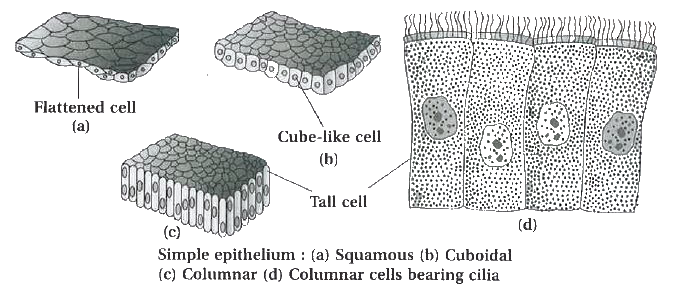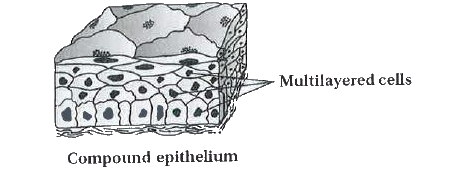Write a detailed note on Epithelial tissue giving types of animal tissue.Solution in Gujrati
According to the function of cells there are four types of tissues found in animals : (i) Epithelial, (ii) Connective, (iii) Muscular and (iv) Neural. Epithelial tissue is known as epithelium. This tissue has a free surface which faces either a body fluid or the outside environment and thus provides a covering or a lining for some part of the body. The cells are compactly packed with intercellular matrix.Epithelial tissue : Epithelial tissues are of two types : (1)simple epithelium (2) compound epithelium. Simple epithelium is composed of a single layer of cells and functions as a lining for body cavities e.g. our skin. (1) Simple epithelium : On the basis of structural modification of the cells, simple epithelium is further divided into three types. These are (a) Squamous, (b) Cuboidal, (c) Columnar. (a) Squamous: It is made up of a single thin layer of flattened cells with irregular boundaries. Cells are arranged with each other like a tile. They are connected by cement material. Cells are almost hexagonal and possesses clear nucleus in the centre. Location : This tissue forms the outer most layer of skin of the frog. Squamous epithelium are found in capillaries alveoli glomeruli, outer layer of skin, of lungs, nephrons of kidney. Function : The main function of this tissue is to protect inside tissues. Cuboidal epithelium : This tissue is made up of a single layer of cube like cells. It possesses clear nucleus in the middle. The cells of this tissue sometimes have micro villies on the free end of absorptive surface eg. renal tube. Location : This tissue is commonly found in ducts of glands and tubular parts of nephrons in kidneys. In ovary and testis they are called as germinal epithelium. Function : These cells take part in processes like secretion of (gastric juice and intestinal juice), excretion and absorption. Columnar epithelium : The columnar epithelium is composed of a single layer of tall and slender cells. Their nuclei are located at the base. Free surface may have microvilli. Their inner ends are narrow and free ends are broad and polygonal. Location : They are found in the lining of stomach and intestine. Function : They help in absorption and secretion. Ciliated epithelium : If the columnar or cuboidal cells bear cilia on their free surface they are called ciliated epithelium. In Their function is to move particles or mucus in a specific direction over the epithelium. They are mainly present in the inner surface of hollow organs like bronchioles and fallopian tubes.

Glandular epithelium : Some of the columnar or cuboidal cells get specialised for secretion and are called Glandular Epithelium. They are mainly of two types : Unicellular glandular epithelium : It consists of isolated glandular cells (goblet cells of the alimentary canal), (ii) Multicellular Glandular Epithelium (salivary gland) : On the basis of the mode of pouring of their secretions, glands are divided into two categories namely (i) exocrine and (ii) endocrine glands. Exocrine glands secrete mucus, saliva, earwax, oil, milk, digestive enzymes and other cell products. These products are released through ducts or tubes. Endocrine glands do not have ducts. Their products called hormones are secreted directly into the fluid bathing the gland.

(2) Compound Epithelium : Compound Epithelium is of two types. That is multilayered, without cells. (a) Stratified Epithelial : In this epithelium, cells forming different layers are not alike. It possesses more than one layered arrangement, so it is found in multilayered form. The cells of lower most layer are arranged on basal membrane. It is known as Malpighian layer. Due to friction/wear and tear cells of free surface become flattened and get eliminated while cells of lower side are added towards new cells by division. Cell which are pushed outside become flattened and become non-living by losing protoplasm cells get depositon of kerotine. The outer surface of stratified epithelia possess squamous epithelium. Stratified epithelium may contain kerotin or may not contain Kerotin.

Location : This tissue is found where mere wear and tear is felt in the part like dry surface of skin, in/living of rectum, buccal cavity, tongue, pharynx, salivary gland, oesophagus and vagina of mammals. Function : It has limited role in secretion and absorption. Their main function is to provide protection against chemical and mechanical stress. Connection between Epitheliums : All cells in epithelium are held together with little intercellular material. In nearly all animal tissues, specialised junctions provide both structural and functional links between its individual cells. Three types of cell junctions are found in the epithelium and other tissues. (i) Tight (ii) Adhering and (iii) Gap Junctions Tight junctions : They help to stop substances from leaking across a tissue. Adhering junctions : They perform cementing to keep neighbouring cells together. Gap junctions : They facilitate the cells to communicate with each other by connecting the cytoplasm of adjoining cells for rapid transfer of ions. (b) Transitional Epithelial : Transitional epithelium is a stratified tissue madeup of multiple cell layers where the cells constituting the tissue can change shape depending of on the distention in the organ. They are in the tracks of excretory organs, They do not possess malpighian layer
Topper's Solved these Questions
- STRUCTURAL ORGANISATION IN ANIMALSBOOK - KUMAR PRAKASHANCHAPTER - STRUCTURAL ORGANISATION IN ANIMALSEXERCISE - SECTION-B (Difference/Scientific Reason)
9 Videos
- STRUCTURAL ORGANISATION IN ANIMALSBOOK - KUMAR PRAKASHANCHAPTER - STRUCTURAL ORGANISATION IN ANIMALSEXERCISE - SECTION-C(DEFINITIONS /EXPLANATION-TERM/LOCATION-FUNCTION)
40 Videos
- SAMPLE QUESTION PAPER FOR SECOND EXAMBOOK - KUMAR PRAKASHANCHAPTER - SAMPLE QUESTION PAPER FOR SECOND EXAMEXERCISE - SECTION - D
1 Videos
- THE LIVING WORLDBOOK - KUMAR PRAKASHANCHAPTER - THE LIVING WORLDEXERCISE - OBJECTIVE SECTION (FILL IN BLANKS)
9 Videos
Similar Questions
Simple Epithelium and Compound Epithelium
View SolutionLigaments
View SolutionExplain Double circulation with the help of chart.
View SolutionA .......... is a collection of pressed, dried and preserved plants mounted on ……..
View Solutionजन्तु ऊतक कितनी प्रकार के होते है ? एपिथिलियमी ऊतक के विभिन्न प्रकारों का चित्र बनाकर वर्णन करो ।
View SolutionWrite shote note on epithelial tissue.
View SolutionAnimal Tissues - Epithelial Tissue
View SolutionANIMAL TISSUES - EPITHELIAL TISSUES
View SolutionAnimal tissues- Introduction|Epithelial tissue
View SolutionWrite a note on glandular epithelial tissue.
View SolutionWhat is epithelial tissue? Write a note on any 3 simple epithelial tissue.
View SolutionAnimal Tissues: Epithelial Tissues|Connective Tissues
View SolutionDescribe different types of epithelial tissue of animals.
View SolutionAnimal tissue || Epithelial tissue
View SolutionAnimal tissues Introduction || Types OF epithelial tissues || Characteristics and specialisations OF cell membranes
View Solution
